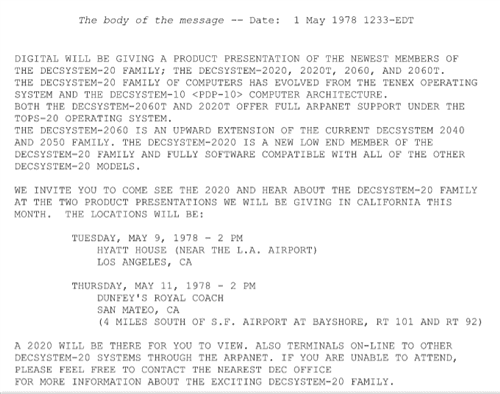
Email Marketing Started 40 Years Ago Today
Some call him “the father of spam.” Others consider him “the father of email marketing.” His name is Gary Thuerk and he was the one who sent out the very first mass email, 40 years ago today.
If you look on the Guinness World Records website, you will find Thuerk as the author of “the world’s oldest spam.” The email, which he composed on the 1st of May 1978, went out on the 3rd of May to almost 400 ARPAnet users.
How did email marketing start?
“The world’s oldest spam was sent at 12:33 EDT on 3 May 1978 by Gary Thuerk (USA), then working for Digital Equipment Corp. (DEC, USA). It was sent to 397 email accounts on the ARPAnet (Advanced Research Projects Agency Network) of the US Defense Dept., inviting them to a product demonstration of the DECSYSTEM-2020, 2020T, 2060 and 2060T computers. ARPAnet is regarded as the predecessor to the internet. The original email still exists,” states the Guinness Book of World Records.

“I thought of it as e-marketing,” says Thuerk, who admitted he knew he “was pushing the envelope.” But he wanted to reach as many people as possible and invite them to test DEC’s new products. As a marketing manager for DEC, Thuerk was hoping to get attention. Of course, his ultimate goal was to increase the company’s revenue.
What happened next?
He received many complaints for his unsolicited email. Above all, an ARPAnet representative called him and “chewed him out,” as Thuerk remembers. On the other hand, the email blast did work: DEC sold almost $14 million worth of its new computers as a result of the mass email.

How email marketing evolved
Since Thuerk’s first email blast in 1978, email marketing has gone through many transformations. As a consequence, marketers and email service providers started to fine-tune their strategies. Let’s take a look at how things have changed:
1991: Internet access gives marketers a new way to reach potential customers. Hotmail offered the first free email service. So the most common email marketing tactic is “spray and pray.”
1998: The Data Protection Act forces email marketers to offer their recipients the possibility to opt out.
2001: The first behavioral email goes out. Marketers realize they need to craft their campaigns according to online user behavior.
2003: The first spam regulations appear. Above all, the Can Spam Law sets new rules for commercial emails.
2004: The Sender Policy Framework appears, as an email validation system for the prevention of email spam. The system verified the sender’s IP address. Email marketing is on the rise. However, intensive spam is its main weakness. Legitimate marketers start to see a serious effect of the ISP’s filtering rules on their campaigns.
2008: Windows Live Sender Reputation Data allows recipients to mark emails as spam. As a result, marketers start to understand they have to refine their strategies if they want to preserve their reputation.
30% of emails never reach the inbox
2009: Email deliverability becomes a topic of discussion, as Return Path reports that 30% of emails never reach the inbox. Recipients now have the option to block certain senders. Due to poor email reputation, many marketers end up on the blacklist.
2010: The continuous development of email marketing and the rise of social media bring focus on data collection and management.
2012: People open more than 40% of marketing emails on a mobile device. Hence, creating mobile-friendly campaigns becomes a priority. In the same year, the European Parliament starts preparations on the General Data Protection Regulation (GDPR).
2016: The European Parliament approves the GDPR. Enforcement date: 25 May 2018.
2018: Email is the most efficient marketing channel, with a revenue of $44 for every $1 spent. Techniques are more sophisticated than ever. Emails are personalized and marketers strive to send valuable content. Email verification becomes an essential part of their strategy as it increases deliverability and helps maintain a good sender reputation.






